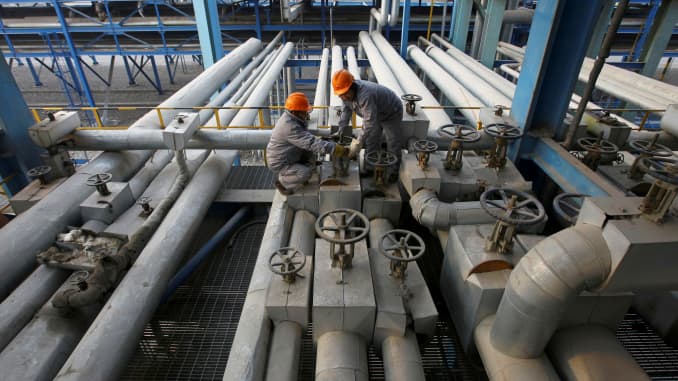Natasha Turak – CNBC – Saudi Arabia has seriously ramped up its oil exports to China in recent months.
How dramatic is the change? Take a look at this graph, which uses data from oil tanker tracking firm TankerTrackers.com.
The Saudi Kingdom’s crude shipments to China have doubled in the span of a year. During the same period, its oil exports to the U.S. have dropped by nearly two-thirds.
According to TankerTrackers.com, which tracks oil tankers and shipments based on satellite imagery and ships’ automatic identification systems, Saudi Arabia exported a whopping 1,802,788 barrels per day (bpd) to China in July, compared to 921,811 bpd in August of 2018. By contrast, exports to the U.S. in July were 262,053 bpd, nearly 62% down from 687,946 bpd in August of last year.
U.S. sanctions on Iranian oil have helped the shift. Major Asian energy importers like China have been forced to shift business away from the Islamic Republic — OPEC’s third-largest producer — and start buying more Saudi barrels to make up for that shortfall.
The U.S. is now more self-reliant than ever, thanks to its own shale oil revolution, which helped it become the world’s largest oil producer by the end of last year.
But the numbers also signal a mix of short-term tactics and long-term strategy for the Saudis, industry experts told CNBC.
Saudis ‘slam on the brakes’ to the U.S.
“Saudi Arabia learned from the last OPEC production cut in 2017 that they got the biggest bang for their buck by cutting flows to the largest, most transparent and most timely market — the U.S.,” said Matt Smith, director of commodity research at commodities analytics firm ClipperData, referring to the coordinated production cut that OPEC and its allies orchestrated to put a floor under falling oil prices.
“Choking back on flows to the U.S. was the best way to draw down inventories and turn around bearish sentiment, and they are employing the same tactic once again.”
ClipperData’s figures, which differ from that of TankerTrackers due to different tracking methods, still show U.S. imports of Saudi crude in July down over 60% from last October.
Meanwhile, Smith said, as Saudi Arabia “slams on the brakes to the most transparent market, it is sending more crude into the most opaque one, China.”
This is where some industry analysts say Riyadh is employing short-term tactics: “impacting what remains the most visible and closely-watched market indicator, U.S. crude stocks,” Antoine Halff, co-founder of energy market analytics firm Kayrros, told CNBC.WATCH NOWVIDEO02:23Here’s where the oil industry may be headed as crude continues to fall
The market has largely traded on weekly U.S. numbers, which — up until the growth of satellite imagery to provide greater transparency on global stocks — provided the best available picture of market conditions.
In spite of the greater availability of global market inventory thanks to satellite data, “the goal of impacting the U.S. stock metric seems to remain very real for OPEC in general and the Kingdom in particular,” Halff said. “Rightly or wrongly, this is the benchmark that everybody watches.”
China, oh the other hand, is not as forthcoming as OECD countries about its stocks, and it’s data isn’t as visible to the market. Halff notes that there is no established benchmark of Chinese stocks as there is for the U.S.
“Producers are far less concerned about building Chinese stocks than they are about building U.S. or OECD stocks in terms of what that may signal to the market,” he said.
China, the ‘savvy buyer’
TankerTrackers.com co-founder Samir Madani has described China as a sort of “black hole” for the world’s oil exports, having the ability to “easily absorb oil barrels from the market, especially when prices dip.” Looking at this, many analysts see a clear strategy from Beijing.
“The Chinese are very savvy and astute buyers, exporters who supply them have very good reasons to do so,” Halff said. In the current low oil price climate, the world’s largest oil importer is happy to up its Saudi crude purchases as its appetite increases, particularly given its launch of two new refineries which will grow its refining capacity by 800,000 bpd.

Employees close a valve of a pipe at a PetroChina refinery in Lanzhou, Gansu province.Stringer | Reuters
In the months following President Donald Trump’s imposition of unilateral sanctions on Iran after withdrawing from the 2015 Iranian nuclear deal, data shows a dramatic run-up in Chinese crude imports and crude inventories. This is “thanks in part, once again, to the availability of Saudi barrels,” Halff added, “whether for precautionary reasons, out of price opportunism, or in preparation for new refining capacity coming online — or all of the above.”
Saudi Arabia’s long game in Asia
Locking in Asian market share is also a key long-term goal for Riyadh, as it is for other regional producers competing to capture downstream capacity across the continent. Saudi Aramco’s plan to acquire a 20% stake in Indian refining and petrochemicals giant Reliance is the most recent example of this.
Conveniently for the Saudis, there’s also no risk of losing the U.S. as a customer, thanks to its giant Aramco-owned Motiva refinery in Texas. Therefore, “Aramco is willing to increase or decrease to the U.S. based on its own needs,” says Ellen Wald, President of Transversal Consulting and author of the book “Saudi, Inc.”
With China, on the other hand, Aramco will meet customer demand when asked because it wants to maintain that relationship, she told CNBC in an email.
“In short,” she said, “Aramco is just fine increasing or decreasing its exports to the United States based on its own needs but in China it wants to fill demand based on the customers’ requests.”



